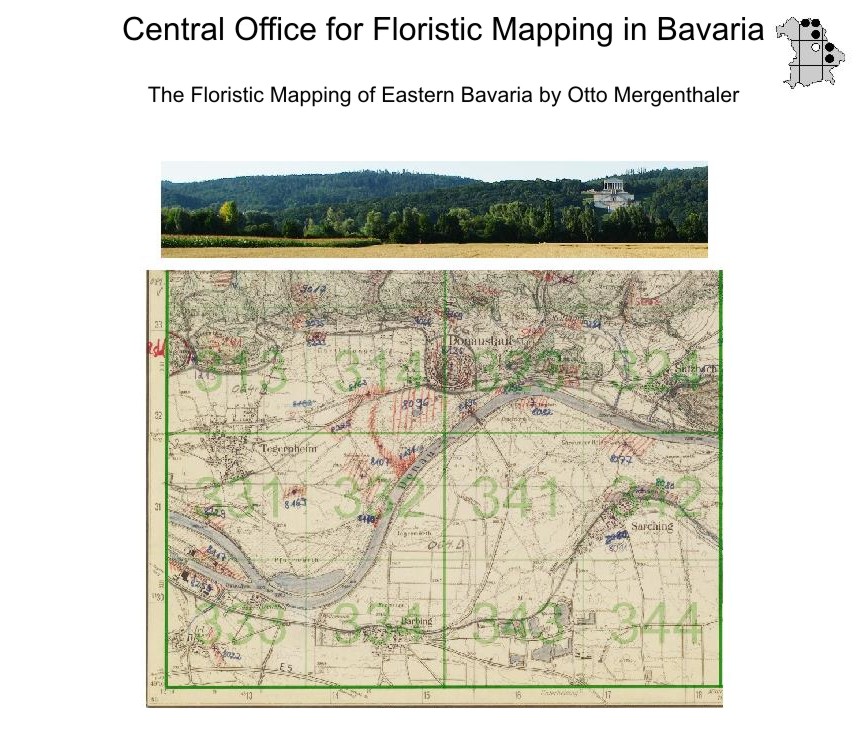IBF Plants
The field work of IBF plants was done in the vegetation periods of 2009 and 2010 and was starting again with the prolongation of the project in 2012. The DFG funded project IBF expired in 2014.
There were several tasks:
The first task is running until recently and devoted on monitoring of ruderal plants on cemeteries in and around Regensburg (Bavaria). These rarely investigated sites bear an interesting and species rich flora. Furthermore, there are many advantages to test "DiversityMobile" on these sites: permanent availability of GPS-data (absence of a closed canopy cover), and the plant species are easy to find without the need to cover a larger distance. This inventory resulted in approximately 20.000 records uploaded to GBIF.
The second task comprised a re-monitoring study based on the research data of Otto Mergenthaler (1898–2001). This well-known botanist collected high-quality data on vascular plants in Eastern Bavaria mostly between 1970 and 1985. The detailed observations are well documented. They were databased already in the 1990th and maps with hand-marked field areas were digitalised at the same time. This was partly done as a project financially supported by the Regierung der Oberpfalz. Data processing and optimization was later done by the Zentralstelle für die Floristische Kartierung Bayerns in Regensburg. In the context of the IBF plants project this original database was transformed and the more than 196.000 data records were integrated in Diversity Workbench components. For botanical research of O. Mergenthaler see O. Mergenthaler: Raumbezogene Feldforschung zum Vorkommen von Pflanzen im nördlichen Ostbayern, 1945 bis 1991.
Based on the images of the topographic maps with hand-marked field areas studied by O. Mergenthaler, investigation areas were selected and monitored to repeat the historical survey. Best suited are moors because these are uniform in terms of their conditions governing location. Several field areas/ plots representing different moor areas (low-level moor and transition moor) in different altitudinal belts are appropriate to be monitored two times per vegetation period.
Another task started in 2012. The new version of DiversityMobile under Windows Phone was tested, especially for managing extended DTN taxon names lists, recording estimated values for species cover-abundance in relation to habitat-type classifications and separately measured environmental variables. The usage of TK25 topographic maps of Bavaria embedded in the Diversity Mobile interface was realised in cooperation with the Bayerischen Vermessungsverwaltung. The service is now available for use within the Flora of Bavaria initiative (login with registration in the Flora von Bayern Wiki and email to the BFL Team). Part of this work package was done by using DWB components on Tablet PC.
Nowadays, the long-term monitoring of vascular plants in Germany is mainly done by volunteers and citizen scientists in connection with the scientific societies like the Bayerische Botanische Gesellschaft e. V. and the Regensburger Botanische Gesellschaft von 1790 e. V.. DiversityMobile with the integrative Diversity Workbench workflow from mobile data gathering, data management in a central data repository up to the data publication via GBIF might be a option for this user community to be part of a sustainable science platform. The scenario was evaluated as a task of its own in 2012 and will be promoted, e. g. by the Flora of Bavaria initiative.
GBIF Data Resource: IBF Monitoring of Plants with IBF Plants About
Scientists in this work package: W. Ahlmer, J. Klotz, Prof. Dr. P. Poschlod
Ecology/Biology, University of Regensburg
- Overview table, IBF Datasets accessible by GBIF and other portals
